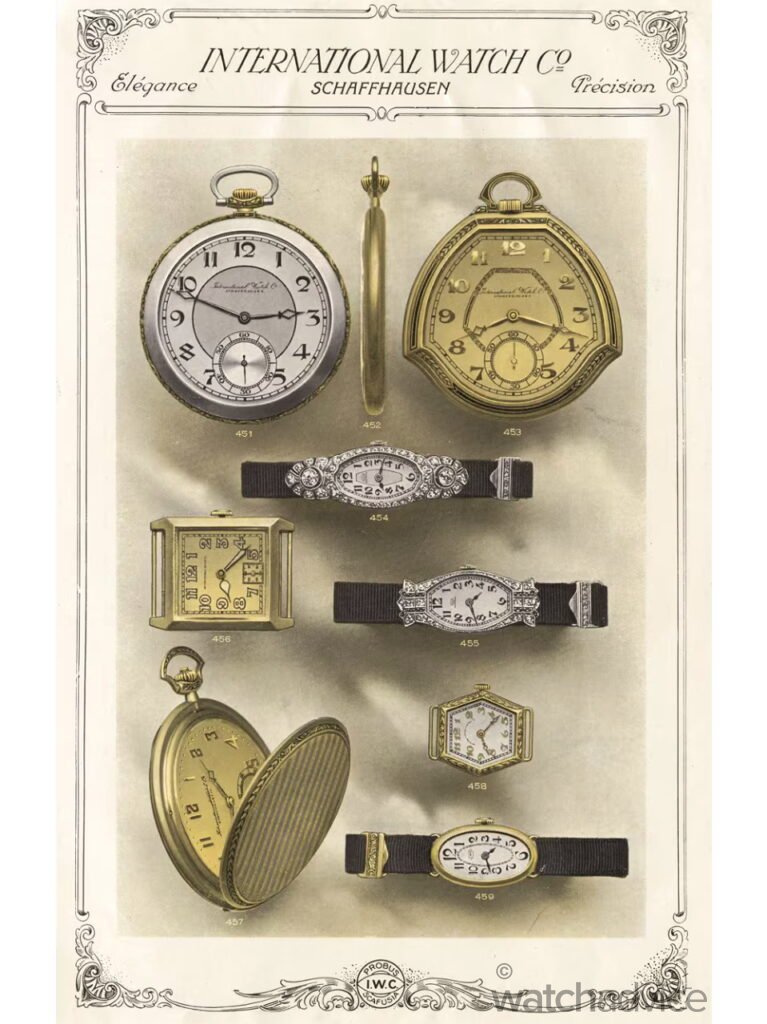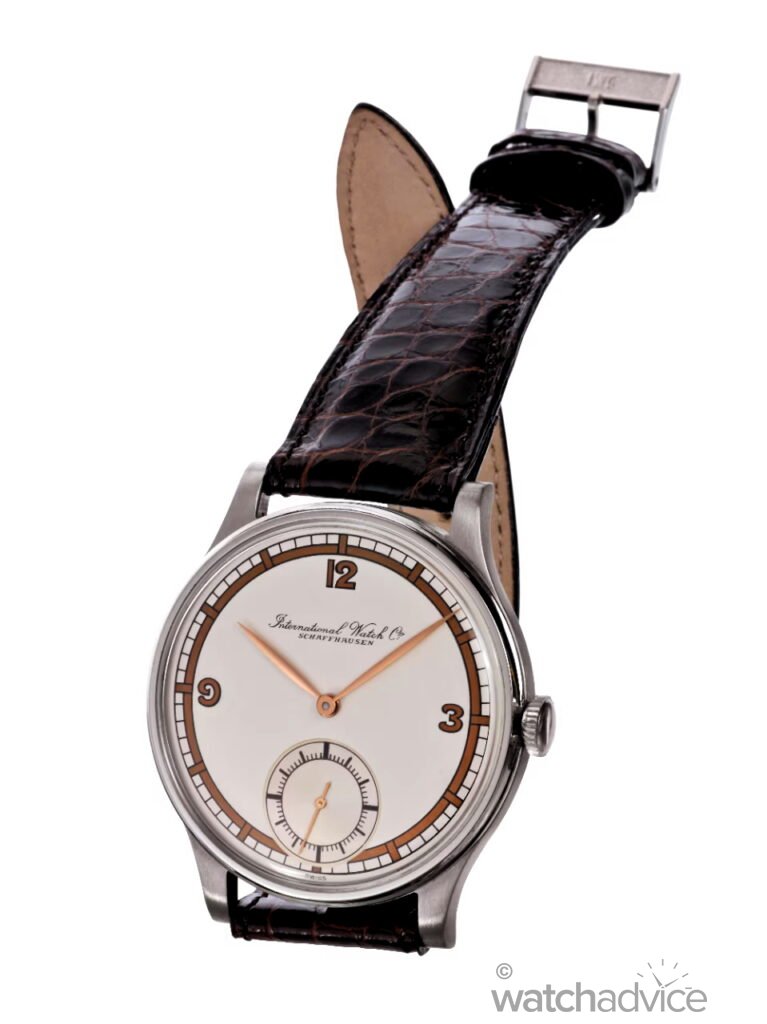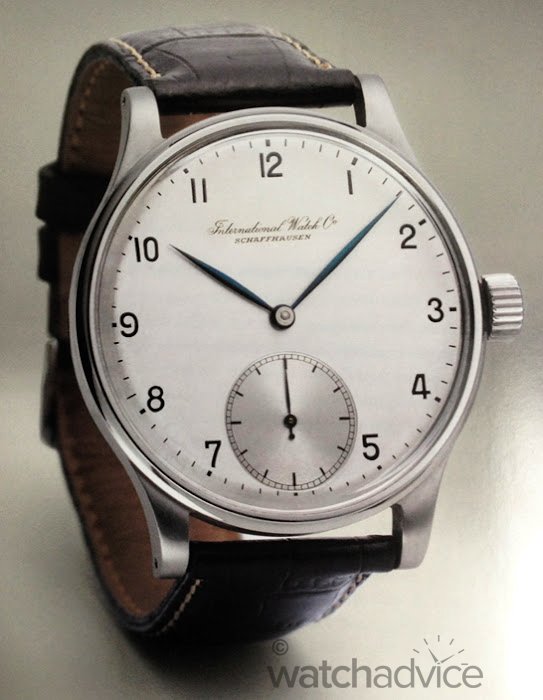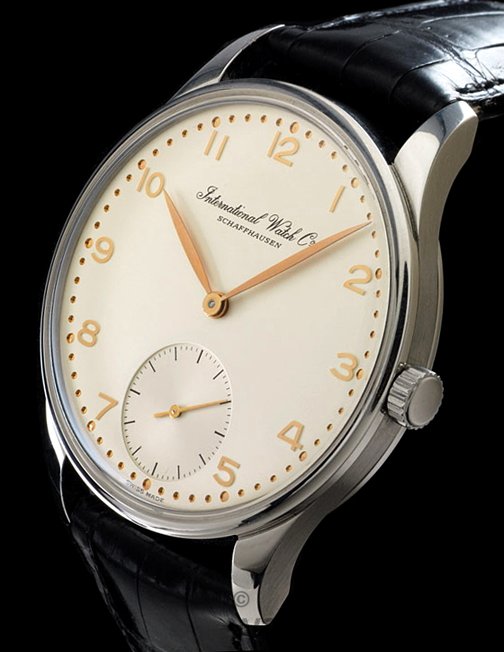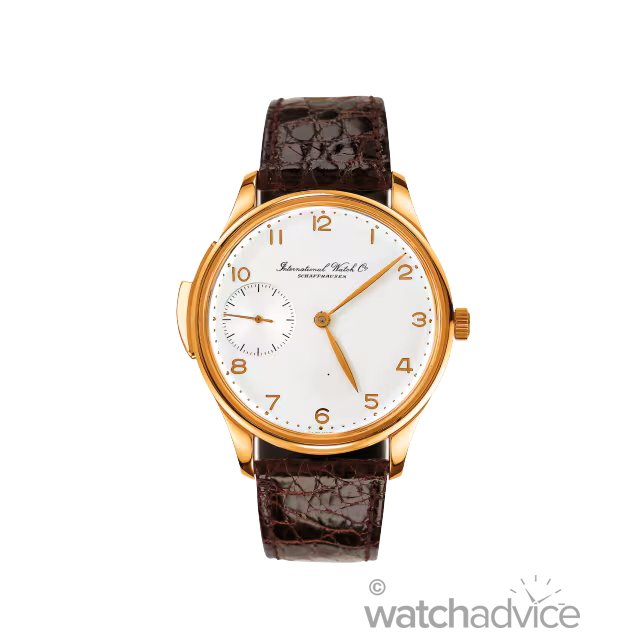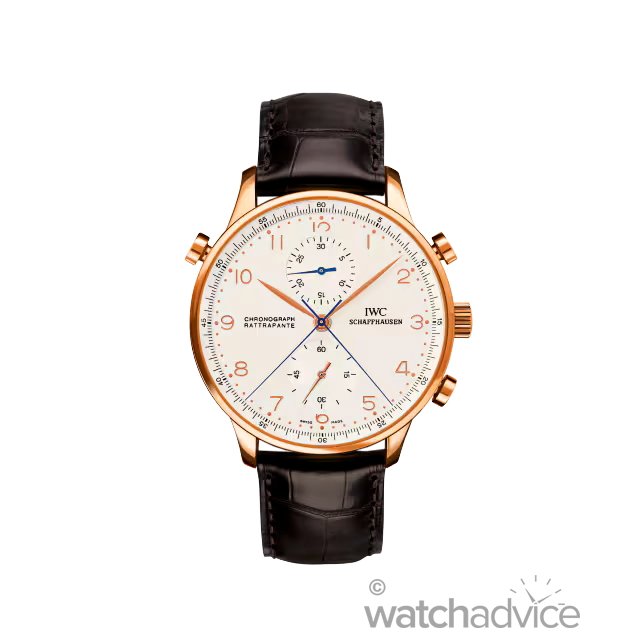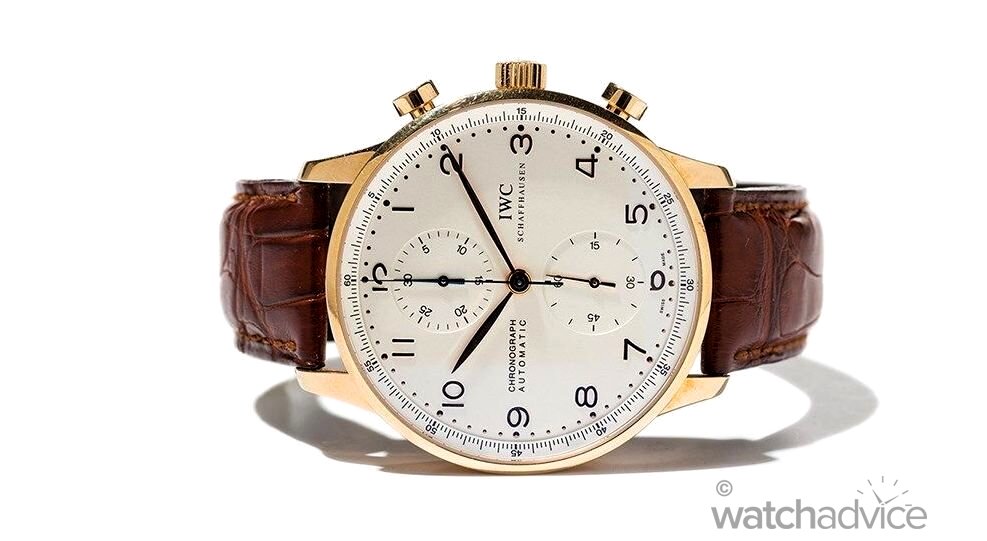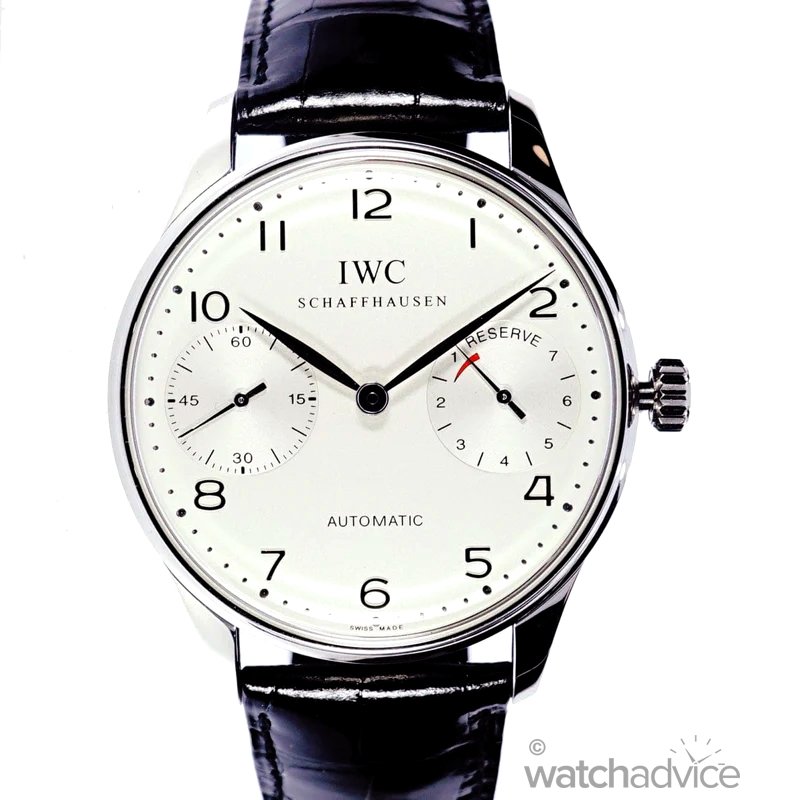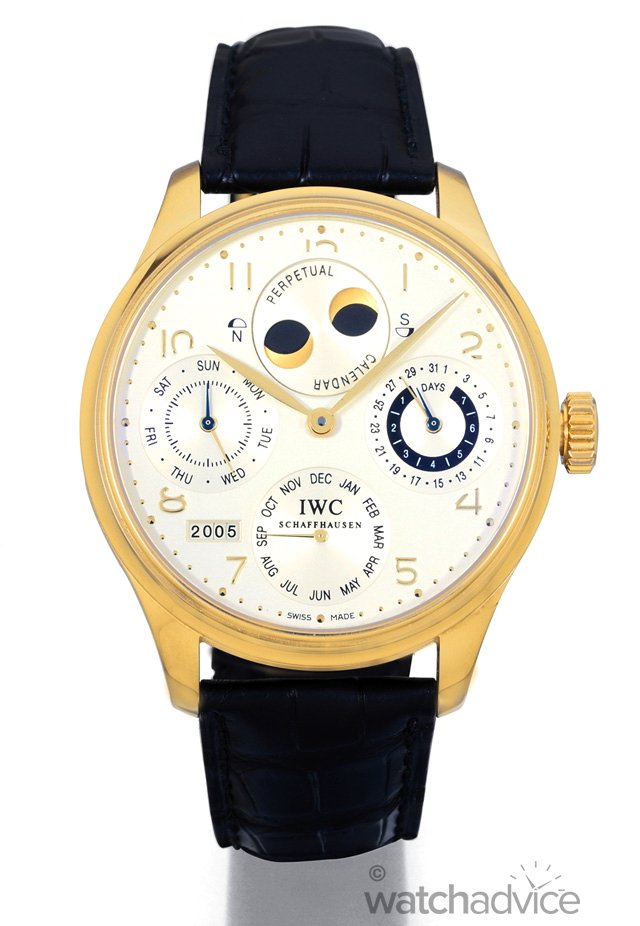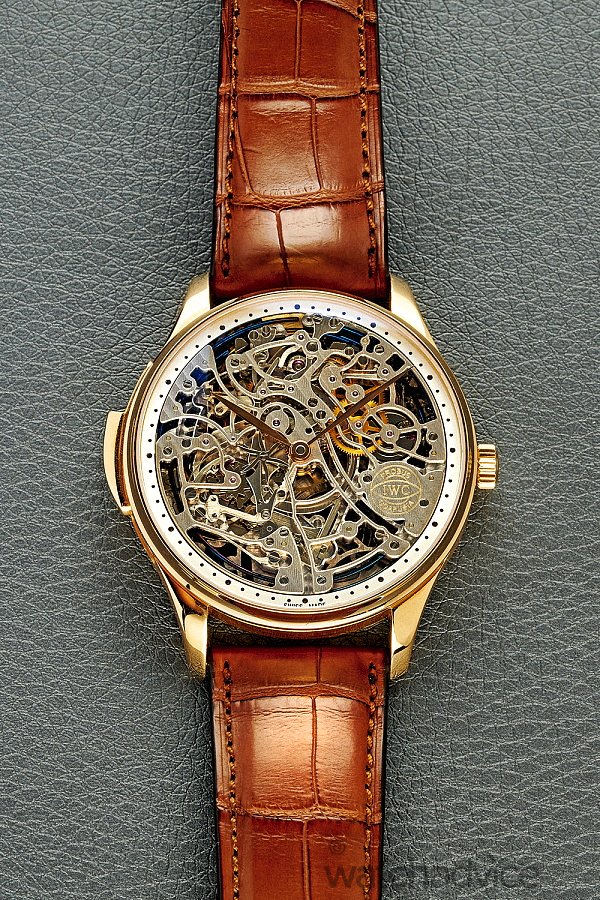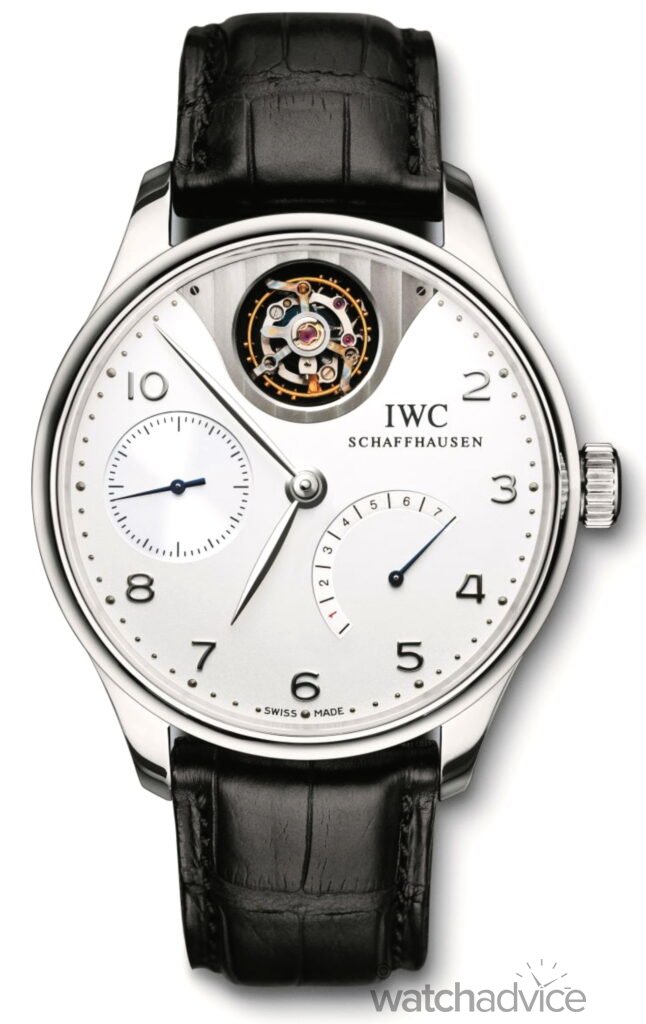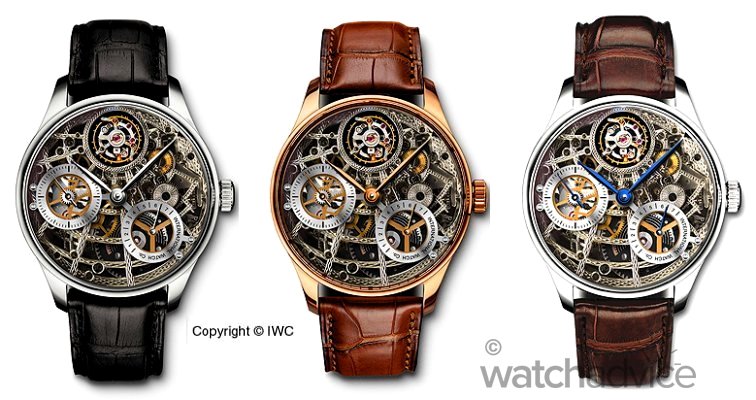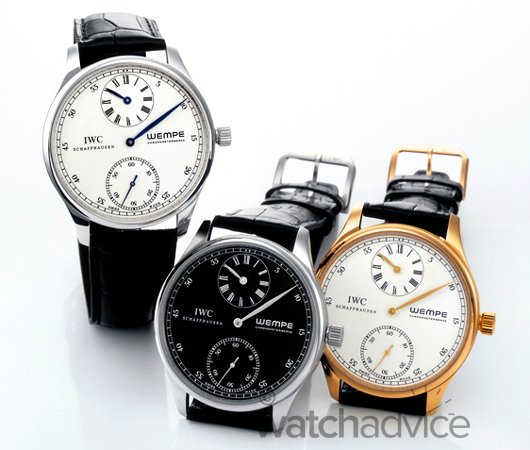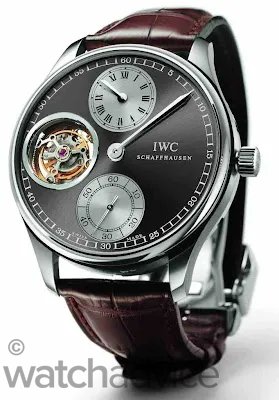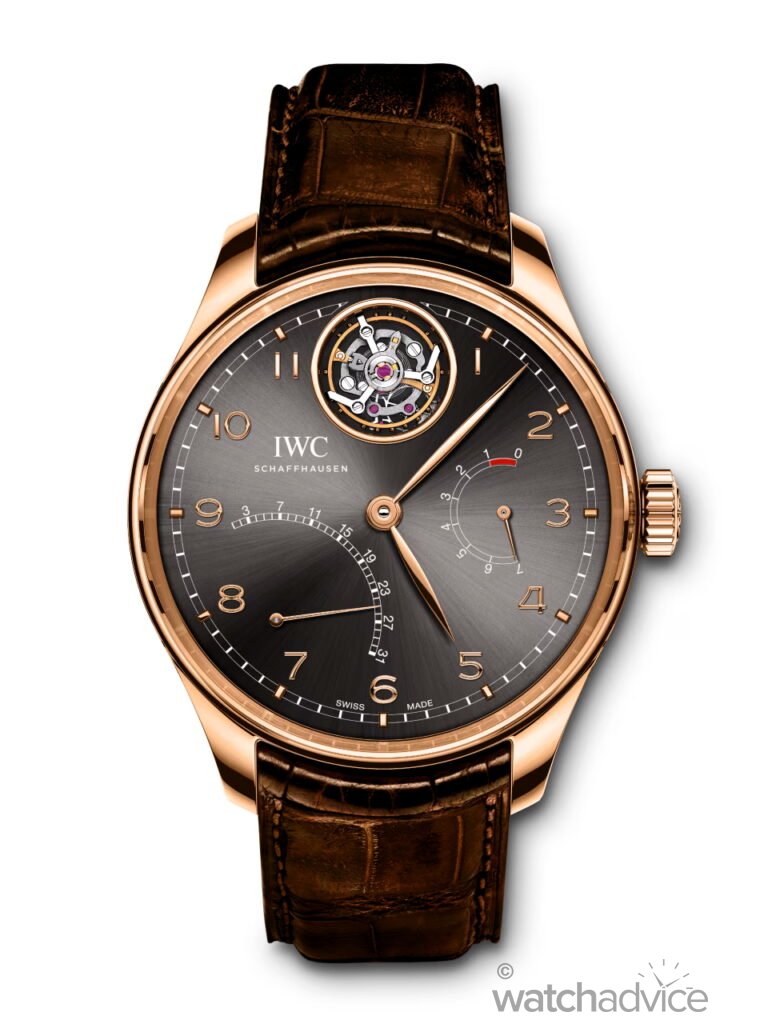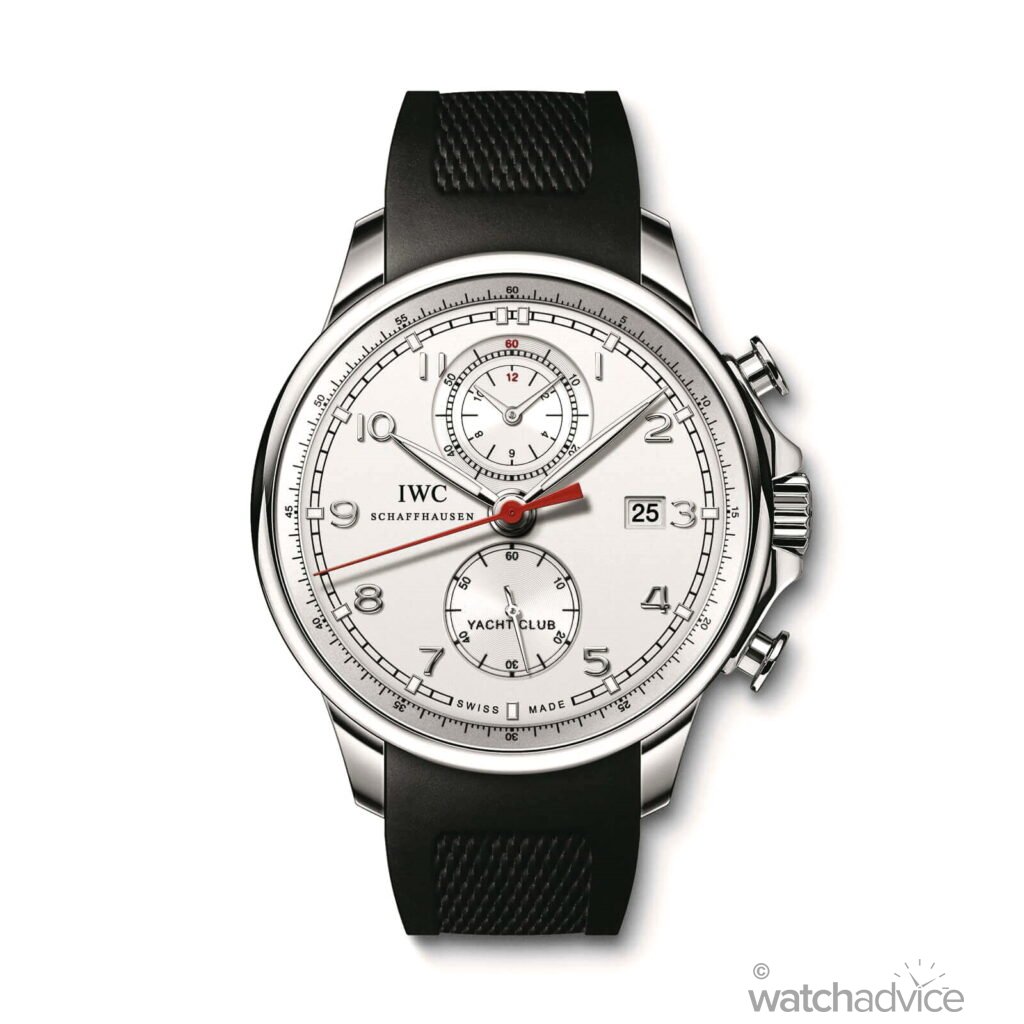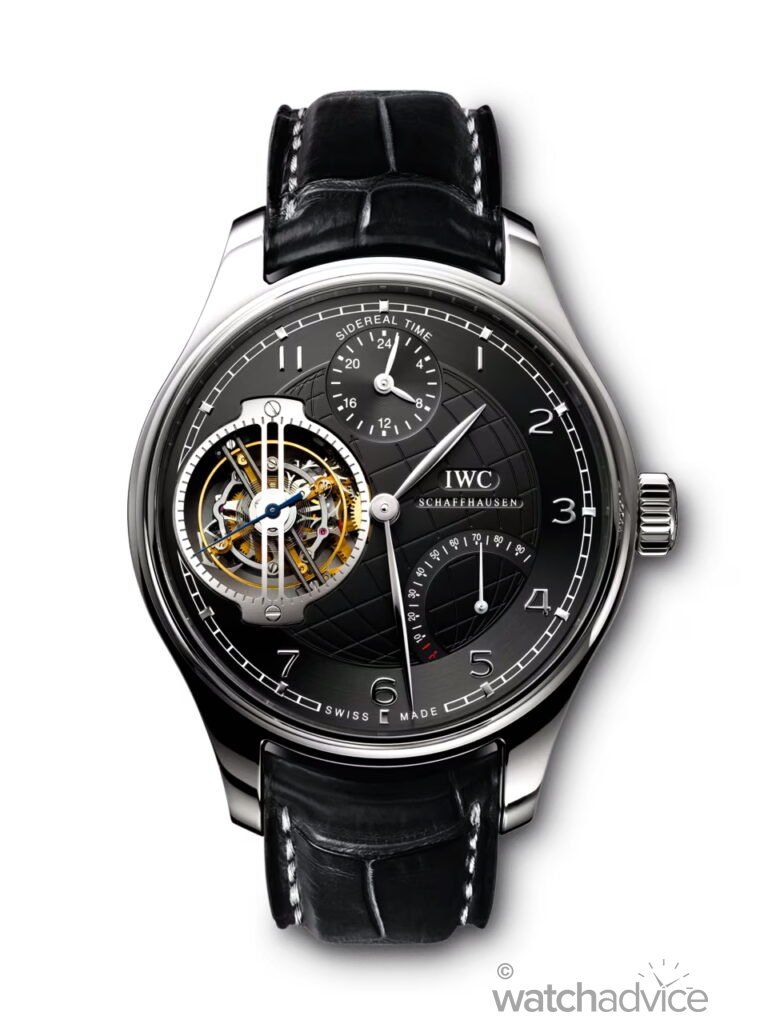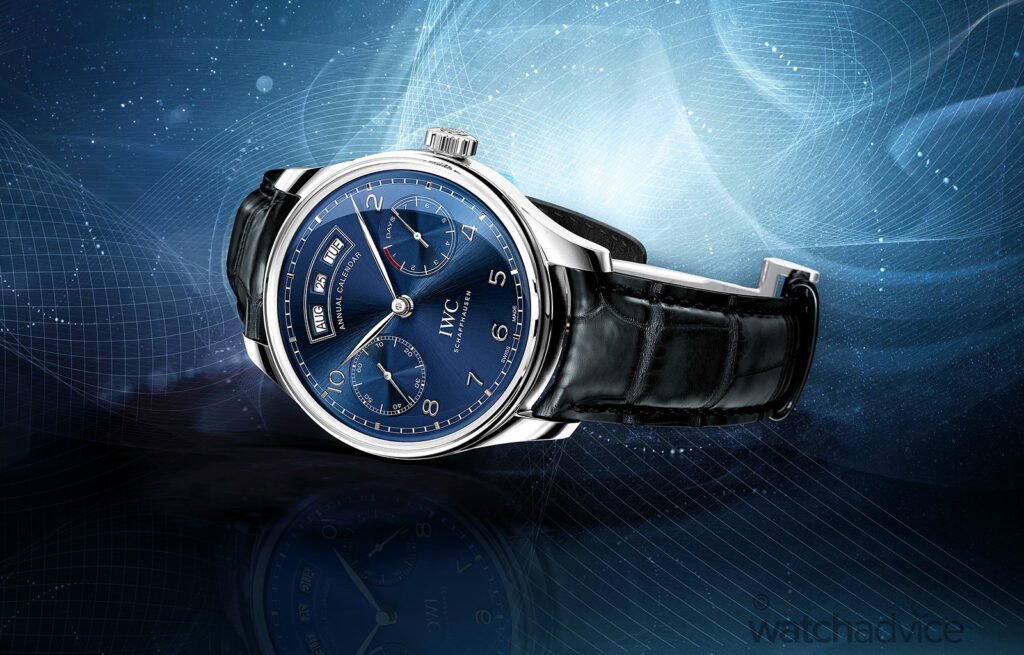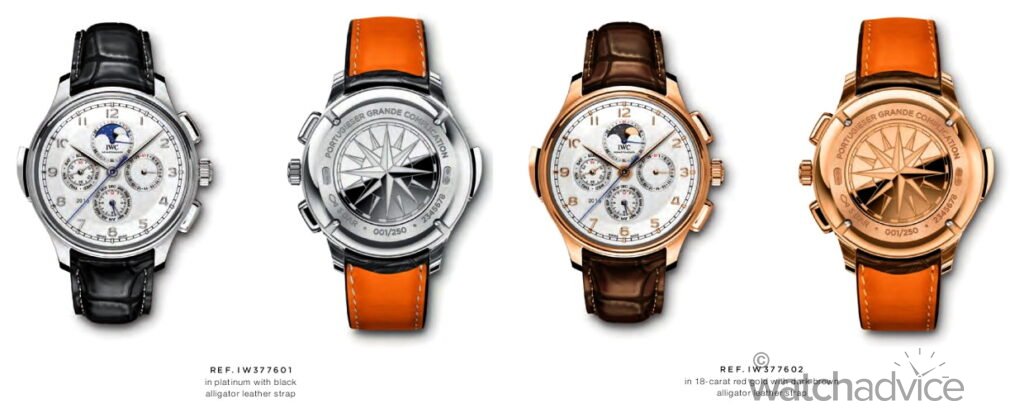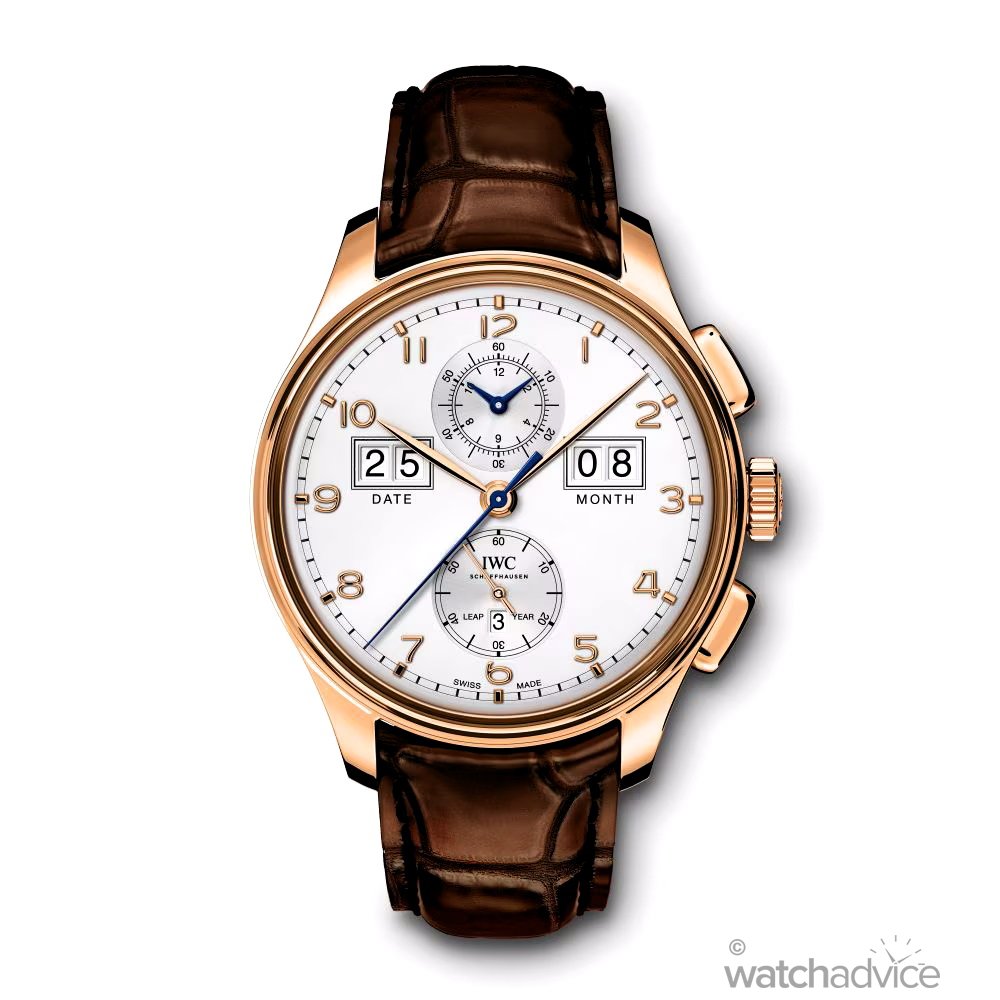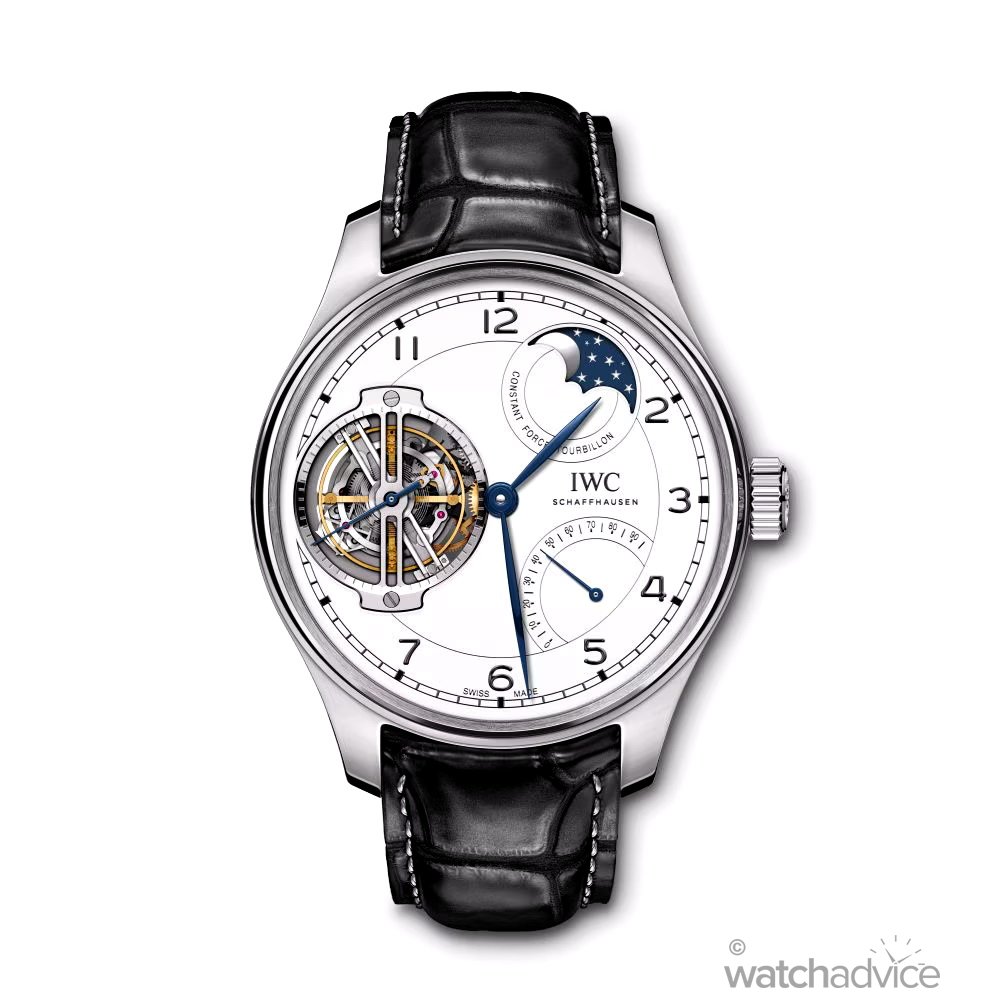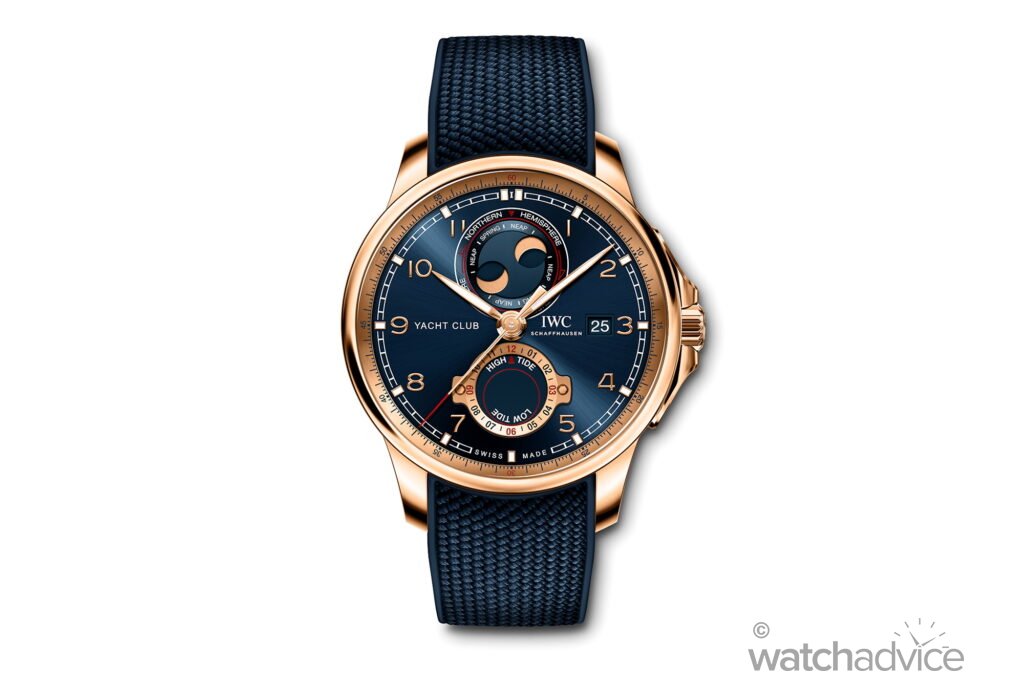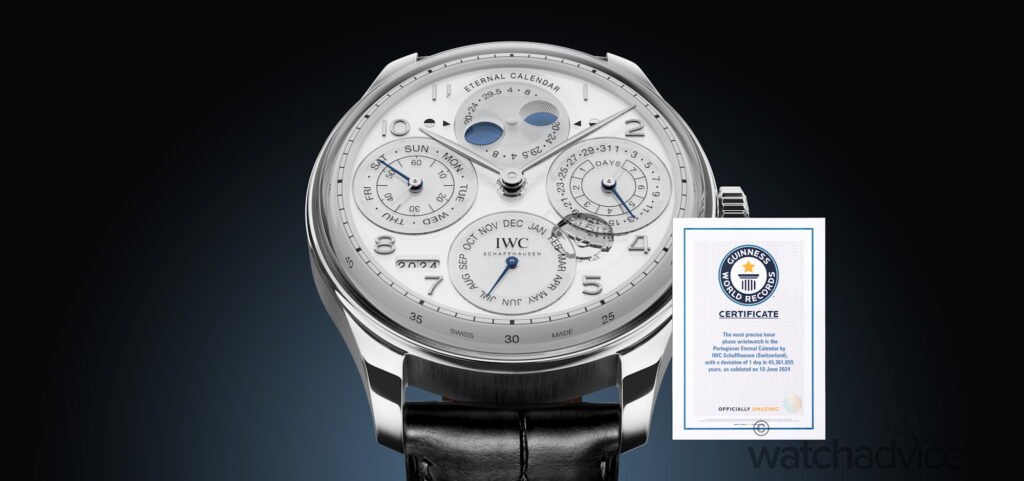From Obscurity to Icon: The Triumphant Journey of the IWC Schaffhausen Portugieser
The IWC Schaffhausen Portugieser is one of the most iconic watches in the world of horology. The Portugieser collection is renowned for its elegance, technical sophistication, and rich history. Only a few watches worldwide have the legacy and status to be icons for watch collectors worldwide.
What makes the IWC Portugieser stand out is its oversized case, clean dial and it’s minimal aesthetics. At the time of it’s initial release, the Portugieser broke away from traditional small, ornate watch design and set a new standard for wristwatches. The Portugieser incorporated cutting-edge calibre, a signature for IWC Schaffhausen, further adding to the allure and appeal of the collection. The Protugieser’s marriage of practicality and elegance caught the attention of watch enthusiasts and collectors, cementing its place in horological history.
2024 IWC Schaffhausen Portugieser Chronograph with horizon blue dial.
To understand the essence behind the Portugieser, we need to look back at its history and the story of how the first Portugieser was created. Back in its early days, the watch was actually named the Portuguese. The Portugieser name was adopted by IWC Shaffhausen in 2015, but more on that later.
The Portuguese were born during a time when Europe was going through economic and political turbulence. The 1930s presented itself as a period where European politics became radicalised, where dictatorships unravelled, and economies were pushed to the limit. Switzerland was a neutral state that depended on exports, and the country’s economy suffered greatly due to these circumstances. It is stated that between 1929 and 1932, “watch sales dramatically declined; like other companies, IWC had to find new markets and sales opportunities.”
To combat the decline in sales, IWC Schaffhausen created and launched a variety of artistically styled men’s and women’s pocket watches and wristwatches. The watches were made in the Art Deco style, with two-dimensional portrayals of floral and organic motifs.
However, during this time, IWC Schaffhausen also housed another design: a pocket watch-style wristwatch, one that would much later bear the name “Portugieser.” For this wristwatch, the designers opted not to use the Art Deco style used for the other wristwatch creations but the Bauhaus style, a modernist theory of design developed primarily in Germany in the 1920s and 1930s. When the watch was released, it was a step ahead of the market and would go on to be an iconic design decades later.
Birth Of An Icon – Portuguese Reference 325
In the late 1930s, while IWC Schaffhausen was trying to break into other markets around the world, a wholesaler from Lisbon, Portugal, approached the Swiss watchmaker. The duo, Messrs. Rodrigues and Antonio Teixeira came with a demand for IWC Schaffhausen to create something special. The Portuguese market at the time was not only for pocket watches and women’s dress watches but also men’s wristwatches that had the precision of marine chronometers. IWC Schaffhausen was able to meet the request to create marine chronometers for Portugal, hence fulfilling the request of Messrs. Rodrigues and Antonio Teixeira.
The very first models to be created for the Portuguese market, however, didn’t actually bear a name or even have a reference number. IWC Schaffhausen states that “IWC’s administration must have equally confused by this case number designation without a reference number. Consequently, someone at the manufacture started using the term that would become later highly noted: “Reference 325”. It is this number which designates the model of the original “Portuguese” wristwatch, even though that model was never shown in any IWC catalog.”
In another turn of events, it was documented that the very first “Portuguese” wristwatch was not actually delivered to Portugal but instead to another country. From IWC Schaffhausen’s sales records show that the first delivery was actually made on 22 February 1939 to a Ukraninan watch wholesaler, L. Schwarcz in Odessa. This Portuguese ref. 325 came with a unique design that was different from what the watch market offered at the time. The watch featured a large ring that connected the hour indices, as well as displaying the 3, 9 and 12 markers in Arabic numerals. The timepiece also came with a constant seconds counter at 6 o’clock.
First Portuguese Delivered To Portugal
The first Portuguese timepieces actually arrived in Portugal three years later, in 1942. The deliveries occurred on the 2nd of February 1942 to the Portuguese wholesaler Pacheco, and then a second batch was received on the 17th of June 1942 to Rodrigues Gonclaves in Lisbon. The delay in deliveries of the Portugieser to Portugal can best be explained best as during the Second World War, Portugal declared its role as neutral, and with Switzerland being landlocked, trade routes were much more difficult. During this period, most Reference 325s were shipped to Eastern Europe. Until 1946, IWC sold this model primarily to two dealers in Bratislava: Kuchàr & Wittmann and Weinstabel.
The first Portuguese ref. 325 models sold in 1942 had an updated design compared to the ones released in 1939. Three years of fine-tuning and development gave the large 43mm Portuguese a much more refined and elegant design, more akin to the Portugieser of modern times. The 1942 reference removed the “indices ring” that was featured on the first Portuguese and instead opted to have 12 Arabic numerals. The constant seconds counter, however, was still retained.
After the Second World War, IWC Schaffhausen states that the sales of the Portuguese ref. 325 were relatively low. In the 1950s, most of the Portuguese models that were produced made their way into Portugal, with the watches having an easily identifiable mark. This special feature was found only in the cases of Portuguese watches delivered to Portugal, which had a stamped hallmark on the case, a mark prescribed by the customs authorities in Portugal. More cases of the Portugese ref. 325 were ordered and produced in the 1950s. However, IWC Schaffhausen states that “for unknown reasons, several of the orders were cancelled. Those cases remained in inventory until the 1970s and subsequently were refinished.”.
The Portuguese story continues. In 1973, IWC’s sales department received a request from Swiss retailer Golay, who showed a great interest in large wristwatches. IWC Schaffhausen took up this request and sold Golay the third-generation version of the Portuguese, now featuring the Calibre 982 movement.
IWC Schaffhausen And Quartz Crisis
This, however, was once again short-lived as well. The sudden and devastating Quartz Crisis that swept the mechanical watch market caused the order from Golay to be cancelled. During this time, Swiss watchmakers were certainly doing it tough, as very few cared about mechanical watches, let alone the beautiful Portuguese. IWC Schaffhausen’s archives have the Portuguese sales estimated as 304 for the Calibre 74 variant of reference 325 and 371 units of the Calibre 982 variant of reference 325.
The Portuguese ref. 325 seemed like it was slowly fading away, with matters getting worse as IWC Schaffhausen’s business proposal during the Quartz Crisis was to evolve into a pocket watch specialist, with the hope that the “small but select group of IWC pocket watch collectors might be interested in a watch with the classic IWC calibre.” A small number of sales of the Portuguese ref. 325 with the Calibre 982 movement were still, however, being made to dealers in Germany, along with a few other retailers in Europe.
IWC Schaffhausen’s story during the Quartz Crisis is one of triumph. Although the brand had a slightly different strategic approach, one genius who worked for the manufacturer had other ideas. Kurt Klaus, born in 1934, was a contemporary watchmaker who started to work with IWC Schaffhausen when he was 23 in 1957. His Da Vinci Perpetual Calendar timepiece, released in 1985, set the mechanical watch world alight, much like other iconic designs at the time, such as Audemars Piguet’s Royal Oak, which pushed back the steady march of Quartz watches.
Related Reading: Masters of Time: The IWC Journey Through the Ages
Rebirth Of The Portuguese Reference 325
Kurt Klaus not only put IWC Schaffhausen back on the map during the Quartz Crisis, he was also instrumental in the ressurection of the Portuguese reference 325. The story goes that at the beginning of the 1990s, a few customers who visited the IWC Schaffhausen workshop noticed that Kurt Klaus was wearing an original Portuguese ref. 325. With the clients showing great interest in the watch, IWC Schaffhausen once again decided to remake the timepiece.
The brand wanted to quickly revive the model, developing an entire line around the Portugese ref. 325. IWC Schaffhausen states that “On the occasion of the company’s 125th anniversary in 1993, IWC decided to bring the special large Portugieser watch back to life with a new limited edition. A special feature was the view of the movement through a transparent sapphire-glass back. The calibre 9828 in the modern Portugieser was based on the original pocket watch calibre 98.” Thus began the story that would lead to the modern-day Portugieser.
1995 – Portuguese Minute Repeater
Shortly after the “rebirth” launch of the Portuguese in 1993, on IWC Schaffhausen’s 125th anniversary, the brand didn’t hold and went straight into giving the watch high complications. The first was released in 1995 and featured the minute repeater complication. The Portguese Minute Repeater (Reference 5240) took the 1993 anniversary case and the watchmakers fine-tuned the movement to fit the minute repeater complication inside. Aesthetic-wise, many of the same elements of the 1993 Portuguese remained. However, the watchmakers shifted the constant seconds counter from 6 o’clock to 9 o’clock to differentiate between the two watches.
1995 – Portuguese Chronograph Rattrapante
As I mentioned earlier, when the Portuguese model was reignited back in 1993, it was like a phoenix rising from the ashes. IWC Schaffhausen wasn’t holding back any punches with the model’s rebirth. In the same year the Portuguese Minute Repeater was released, IWC Schaffhausen also released the very first chronograph complication for the model. It wasn’t just an ordinary chronograph complication either; the brand went hard with the complication, even having the slogan “A watch that had never existed before, even back then” for the Portuguese Chronograph Rattrapante. The result was certainly extraordinary, with the Portuguese Chronograph Rattrapante being one of the most beautiful versions of this complication created, even till today! This model is also when we first see the logo change, which is now seen in modern-day IWC Schaffhausen timepieces.
1998 – Portugese Automatic Chronograph
In 1998, IWC Schaffhausen released one of the most iconic versions of the Portuguese model, which is still relevant and highly sought after even to this day. The Portuguese Automatic Chronograph’s (reference 3714) styling is unmistakable. it featured the Portuguese’s classic Arabic hour numerals, the dual chronograph counters at 6 and 12 o’clock and the collection’s beautifully elegant hands. Its such an iconic design that, the 2024 Portugieser Automatic Chronograph is almost identical in terms of aesthetics to this 1998 version.
2000 – Portuguese Automatic 2000
To mark the new millennium, IWC Schaffhausen wrote a brand new chapter in the history of the brand. This was beautifully executed through the creation of the Portuguese Automatic 2000 (Reference 5000). What set this Portuguese apart from the rest is that it came with the in-house movement calibre 5000. This movement featured a bi-directional Pellaton winding system and beats at a frequency of 18,000 VpH. The most impressive feat of the movement, however, was that it gave a power reserve of 168 hours or seven days!
2003 – Portuguese Perpetual Calendar
In 2003, IWC Schaffhausen fitted the Portuguese with the Perpetual Calendar complication for the very first time. The complication was, of course, developed by Kurt Klaus, as he was the genius behind IWC Schaffhausen’s first perpetual calendar complication on a wristwatch, with the release of the Da Vinci Perpetual Calendar in 1985. The brand states in regards to the Portuguese Perpetual Calendar, “In a unique and very special way, this timepiece embodied all the watchmaking expertise of the Schaffhausen company. IWC combined its in-house 5000 caliber with the perpetual calendar module developed by Kurt Klaus.”
2004 – Portuguese Minute Repeater Squelette
In 2004, the brand released a skeletonised version of their Portuguese Minute Repeater timepiece, which was released in 1995. The timepiece came with a rose gold case 750/1000, with a sapphire case back. The skeletonised dial was intricately designed to have an artistic appeal to it. The watch featured IWC Schaffhausen’s calibre 95911, a manual winding movement that had a power reserve of up to 43 hours. This was a limited edition timepiece of 50 pieces.
2004 – Portuguese Tourbillon Mystere
Up until 2004, the Portuguese family included almost every classic watch complication. IWC Schaffhausen introduced the most mythical of them all into the collection with the release of the Portuguese Tourbillon Mystere (reference 5042). The Portuguese Tourbillon Mystere was offered in platinum/silver and was a limited edition model of 50 units. The 44mm timepiece encased a simplistic yet highly complicated dial, in which the tourbillon escapement was placed at 12 o’clock, power reserve between 4 and 5 o’clock and constant seconds counter at 9 o’clock.
2004 – Portuguese Tourbillon Mystere Squelette
Following the release of the Portuguese Tourbillon Mystere, IWC Schaffhausen released a skeletonised dial version of the timepiece in the same year. The timepiece is a work of intricate mechanical art. The skeletonised architecture of the dial shows a web-like structure leading out from the tourbillon escapement at 12 o’clock. Like the original Portuguese Tourbillon Mystere, the timepiece features a power reserve indicator between 4 and 5 o’clock and a constant seconds indicator at 9 o’clock.
2005 – Portuguese Regulator for Wempe
The Portuguese Regulator was a timepiece released in 2005 for the German luxury retailer Wempe. It went back to IWC Schaffhausen’s historical roots as it told the time through three different dials. The watch featured only one main hand, which told the minutes on the dial. The sub-dial at 12 o’clock showcased the hours, while the sub-dial at 6 o’clock showcased the seconds. This timepiece was undoubtedly a throwback to a time when this characteristic separation of hours, minutes, and seconds was reserved for marine chronometers or master clocks.
2007 – Portuguese Regulator Tourbillon
In 2007, IWC Schaffhausen released the Portuguese Regulator Tourbillon in a limited edition release of 100 units, with the models being presented in platinum, white gold and rose gold. With the tourbillon complication making its way for the first time into the Portuguese collection in 2004, the brand now had more freedom to experiment with the design. The Portuguese Regulator Tourbillon has the tourbillon escapement at 9 o’clock, while the time reading sub-dials for the regulator remains at 6 and 12 o’clock.
2010 – Portuguese Tourbillon Mystere Retrograde
For SIHH 2010, IWC Schaffhausen released the Portuguese Tourbillon Mystere Retrograde. While this model may seem like just a retrograde upgrade of the Portuguese Tourbillon Mystere, there is a slight complication variation. With the tourbillon retained at 12 o’clock position, the retrograde power reserve is displayed at 3 o’clock, with the red indication meaning low power. What used to be the constant seconds counter on the Tourbillon Mystere at 9 o’clock has now been changed to a retrograde date function on this model
2010 – Portuguese Yacht Club Chronograph
2010 was the year that IWC Schaffhausen decided to incorporate the “Yacht Club” design into the Portuguese family. The Yacht Club is rooted deep in IWC Schaffhausen’s history, with the model being first released in 1967. The IWC Yacht Club is seen as one of the last representations of the best of mechanical watches before the Quartz Crisis. The Yacht Club timepiece was aimed at the more casual market, while still having ties to life at sea. The Portuguese Yacht Club Chronograph (reference 3902) carries this same ideology and is a timepiece combining sportiness and elegance.
2011 – Portuguese Siderale Scafusia
The Portuguese Siderale Scafusia (reference 5041) was a watchmaking marvel released in 2011. This masterpiece in haute horlogerie represented ten years of solid development work by a team of master engineers, watchmakers and scientists. The Portuguese Siderale Scafusia came with a patented constant-force tourbillon displayed at 9 o’clock on the dial, the sidereal time shown at 12 o’clock, power-reserve showing 96 hours between 4 and 5 o’clock, and a customised celestial chart showing the host of features on the case back.
2015 – Portugieser Annual Calendar
2015 was an important year for the Portuguese family. This was the year in which the Portuguese line celebrated its 75th anniversary, and as a part of this, two historic moments were made. Firstly, the now iconic Portuguese line had its name changed to Portugieser. Secondly, a range of limited edition models was released to celebrate the 75th anniversary, with one of the timepieces being the Portugieser Annual Calendar. IWC Schaffhausen redeveloped its annual calendar, which, on this portugieser, now displays the month, date, and day in three separate windows on the dial, and the movement only requires one adjustment per year.
2015 – Portugieser Grande Complication
At SIHH in 2015, as part of the Portugieser’s 75th anniversary celebrations, IWC Schaffhausen released the most complicated version of the model ever. The Portugieser Grande Complication (reference 3776) brings together in its elegant 45mm case a perpetual calendar complication, a perpetual moon phase display, a chronograph and a minute repeater complication, just to name a few. There are 20 functions on the timepiece, with 659 individual mechanical parts making the magic happen.
2015 – Portugieser Perpetual Calendar Digital Date-Month Edition
Another release as part of Portugieser’s 75th anniversary is the Perpetual Calendar with the digital date month display. As the name suggests, IWC Schaffhausen as removed the sub-dials for the date and month of the perpetual calendar complication to now make way for digital displays. This display certainly makes for a simpler viewing of the perpetual calendar complication. The timepiece also comes with a flyback chronograph feature.
2018 – Portugieser Constant-Force Tourbillon Edition “150 Years”
To mark the 150th anniversary of IWC Schaffhausen, the brand released a limited edition of 15 timepieces: the Portugieser Constant-Force Tourbillon Edition “150 Years.” The 46mm platinum case housed a remarkable movement and a beautifully laid-out dial. The IWC-manufactured 94805 calibre movement is manual wound and pushed out an operating frequency of 18,000 VpH and a power reserve of 96 hours. The movement features were shown through the dial, with the constant-force tourbillon at 9 o’clock, the power reserve display between 4 and 5 o’clock and the moon phase display at 1 o’clock.
2020 – Portugieser Yacht Club Moon & Tide
In 2020, IWC Schaffhausen presented a brand new Portugieser Yacht Club. This timepiece was unique to the previous generation of the Portugieser Yacht Club in that it now displayed the moon phase and a tide indicator on the dial. The sub-counter at 6 o’clock showcases the tide indicator, which was a technical feat from IWC Schaffhausen. The sub-counter at 12 o’clock shows another brand speciality, which is the double moon phase display. This moon phase display has now also been expanded to show the spring and neap tides and thus provides more information about the strength of current tides.
2024 – Portugieser Hand-Wound Tourbillon Day & Night
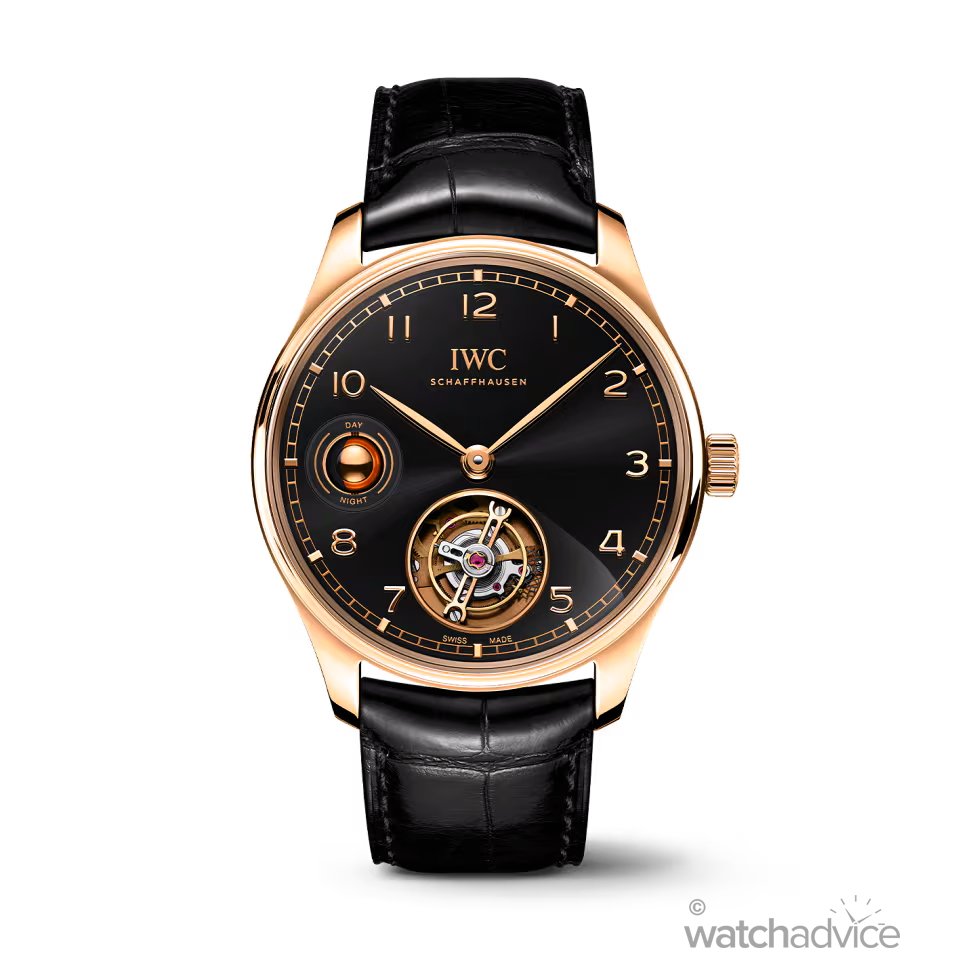
Released during Watches and Wonders 2024 was the Portugieser Hand-Wound Tourbillon Day & Night. This timepiece was presented in an 18-carat Armor Gold case (IWC Schaffhausen’s own take on red gold), with a deep black obsidian dial. This black dial is the perfect choice to accentuate the tourbillon at 6 o’clock and the day and night indicator at 9 o’clock. This day and night indicator is unlike any other. The small round ball on the indicator is split down the middle in dark black or gold, which will turn as time passes to indicate how far along the day and night it is.
2024 – Portugieser Eternal Calendar
The pinnacle of calendar complications came with the release of the Portugieser Eternal Calendar. Who knew that a watch on the brink of being forgotten about would one day go on to break world records? The Portugieser Eternal Calendar was IWC Schaffhausen’s first secular perpetual calendar, which automatically accounts for the Gregorian calendar’s complex leap year exceptions by skipping three leap years over a 400-year period. The watch received a Guinness World Record for the moon phase display on the timepiece, as it is so precise that it will (theoretically) only deviate by one day after 45 million years.
Related Reading: IWC Schaffhausen Receives Guinness World Record For The Latest Portugieser Eternal Calendar
As shown throughout IWC Schaffhausen Portgieser’s history, it is one of resilience, innovation and triumph. Despite its large, unique design when it was first released in 1939, the Portuguese timepiece did not enjoy immediate success. The oversized case design and the minimal aesthetics on the dial were far beyond the era it was released in, and for decades, the Portuguese was slowly fading away into the pages of history. For a long period of time, even though the Portuguese had small sales, IWC Schaffhausen had no intention of bringing the model back into large-scale commercial production.
The “rebirth” of the Portugieser is as iconic as the watch itself. After the Kurt Klaus put the watch back into the spotlight, the 125th anniversary of the brand marked the occasion in which the Portugieser would make it’s return, and this time it was here to stay.
Fast forward to today, and the Portugieser has broken records once thought unimaginable. The collection has become a symbol of IWC’s mastery of both design and engineering. The use of different complications such as perpetual calendars, tourbillons, constant-force tourbillons, annual calendars, tide indicators, rattrapante and minute repeaters has pushed the Portugieser to new heights, earning it respect and love from collectors and enthusiasts worldwide.
The Portugieser’s journey from near obscurity to breaking world records showcases the timepiece’s remarkable resistance and IWC Schaffhausen’s commitment to pushing the boundaries of innovation. It’s certainly a captivating story of how the Portugieser almost didn’t survive the changing tides of fashion to embody timeless elegance and mechanical mastery, turning it into one of the most iconic timepieces in the world of horology today.


